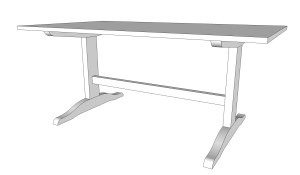
According to John Gloag’s “A Social History of Furniture Design: From B.C. 1300 to A.D. 1960,” there are only two forms of furniture: a box or a platform.
When it comes to boxes, nothing is more boxy than a chest (see yesterday’s entry on six-board chests). When it comes to platforms, nothing supersedes a trestle table. Since at least Medieval times, trestle tables have been a staple of the finer castles, manors and huts of the Western world.
The history of trestle tables fascinates me. But it would probably bore most of you. So let me deal only with the juicy parts. Before the Georgian period, the tops of trestle tables tended to be quite narrow, according to David Knell’s “English Country Furniture: 1500-1900.”
Why so narrow? Because diners sat on only one side of the table with their backs against the wall. Diners didn’t sit across from one another. This seating arrangement allowed servants to serve from one side, but it also had a much more practical purpose. In case you were attacked while eating (how rude!) you could flip the table so it served as protection against your attackers.
Another benefit: You could use the benches (usually called “formes”) that were secured to the wall of your hut or holdfast.
As home security improved and dining mores changed, the trestle table became wider but shorter in length. But its basic form survives basically unchanged to the present day.
The trestle table is an early achievement of structural engineering. It is lightweight – I can pick up an 8’ example with one arm – and yet it is impossibly sturdy. It requires a minimum amount of material. It is portable. And, most of all, it is a beautiful form.
From the ends, a trestle table looks like a tree, with prodigious roots, a straight bole and arching branches that support the tabletop.
So perfect is this form that it can be quite hard to date trestle tables accurately. Yes, you can use fasteners and patina to guide you, but those are the same things that guide the furniture forgers or refinishers. Relying on the form or ornamentation is useful if the table has a distinctive form or any ornamentation. Many have neither.
So we are left scratching our heads but admiring the lines of tables such as the one I drew above. Is it English or American? Auctioneers (respected ones) could narrow the date of its construction down to a 100-year period. But was that between 1700 and 1800? Or 1800 to 1900? Or later?
That’s the beauty of this piece and many other trestle tables. Remove the patina and these tables could be at home in the Tower of London or any tower of excess in Manhattan.
This example is 65-1/2” long, 38” wide and 28” high. So we know that it was built after the Georgian period. But after that….
— Christopher Schwarz